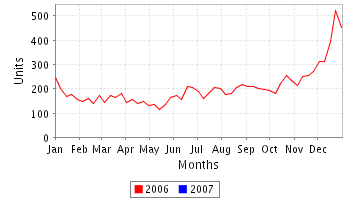Yesterday, I talked about the overall state of the computer book market. In this installment: category visualizations and trends showing which technologies are winning and which are losing in the book market. Here’s a treemap view of
the quarter on quarter differences between Q4 of 2006 and the same period last year:
As I’ve previously described in
Book Sales as a Technology Trend Indicator, in a Treemap
visualization, the size of a square indicates the relative size
of the category, and its color indicates the rate of change. A
category that is bright green is up significantly. One that is
bright red is heading strongly in the other direction. Colors
that are more muted show smaller rates of change. For this image, I’ve also dragged a
slider to show the enclosing category hierarchy, so only the top
level categories are proportionally sized.
As you can see
from the controls at the top of the display, we’re showing
quarter on quarter unit sales compared to the same period in the
previous year. (Note: quarters are 13 week periods as closely
aligned to calendar quarters as possible. Because Neilsen
reports data weekly, and weeks don’t match up exactly with
quarters, we do a best fit.)
The entire market was down 4% in unit sales versus the same period a year ago, but a quick glance at the treemap shows where the biggest problem is: Consumer Operating Systems and Devices, down 18%, Business Applications, down 8%. As I wrote last week, we’re assuming that the market is waiting for books on Vista, Office 7, and Mac OS X Leopard. However, much of the Professional Programming and Systems Administration super category is also down, albeit at a smaller 4%, and even Digital Media applications are showing an anemic 1% growth, despite the huge growth in the sales of books on the iPod. (But for that, even the digital media category would be down.) But once again, the market is awaiting new releases of Adobe products some time next year. Web Design and Development, up 7%, is the only top level category showing continued growth.
Let’s now take a closer look at each of these top level categories.
Professional Programming and Systems Administration
As you can see, there is more red than green, by a long shot. Bright spots in the market include SQL Server and to a lesser extent MySQL, as well as data warehousing and data analysis; open source programming languages Python and Ruby; “Linux Other” (which really these days means Ubuntu); and software engineering topics like project management, agile programming, object oriented programming, and user interface design; Cisco; and .Net programming.
Notable books leading individual categories include Microsoft Press’s MCTS SQL Server 2005 Self Paced Training Kit and Inside Microsoft SQL Server 2005: T-SQL Querying; Sams’ MySQL Crash Course and O’Reilly’s MySQL Cookbook; Wiley’s The Data Warehouse Toolkit; Edward Tufte’s Beautiful Evidence, SAS’ The Little SAS Book and O’Reilly’s Information Dashboard Design; the Pragmatic Programmers’ Programming Ruby and O’Reilly’s Ruby Cookbook; O’Reilly’s Learning Python; O’Reilly’s Ubuntu Hacks; Rita Mulcahy’s self-published PMP Exam Prep (which was the single biggest revenue generating title in the industry for all of last year!); O’Reilly’s Head First Design Patterns and Head First Object Oriented Analysis and Design; Cisco Press’ CCNA Offical Exam Certification Library; and Microsoft’s MCTS Self Paced Training Kit. (Your mission, should you choose to accept it, is to match up those titles with the categories they are from, as given in the paragraph that precedes this one :-)
A Closer Look at Computer Languages
As explained in previous postings, our data warehouse looks at books along several dimensions. For computer languages, the pure category view doesn’t give the most accurate results, because the language is not necessarily the right primary categorization for a given book. For example, Manning’s hot new book Java Persistence With Hibernate is categorized as a database book, not as a Java book. But in the programming language dimension, it will be counted for Java.
For the most accurate view of how computer languages are stacking up against each other in the book market, take a gander at the following treemap, which shows the language dimension:
At this scale, all the percentages are readable, so I won’t belabor the obvious, other than to note that Ruby is now ahead of both Python and Perl. And it’s worth noting that Actionscript is really just a variant of JavaScript, and that books labeled .Net Languages are books that include both C# and VB.Net, so they should be counted with C#. The net-net is that C# has definitely passed Java in the book market.
Web Design and Development
Here’s the Q4 year-on-year treemap for Web Design and Development. It’s self-explanatory:
Digital Media
Here’s the Q4 year-on-year treemap for Digital Media:
Probably the most remarkable single title in this category is Scott Kelby’s The IPod Book, which has surpassed
Business Applications
Here’s the Q4 year-on-year change in the business applications category:
Consumer Operating Systems and Devices
Here’s the Q4 treemap for consumer operating systems and devices, compared to the same period last year:
Again, this is mostly self-explanatory, except perhaps the category “Mac Guides”, which includes books on the Mac as a whole (rather than the operating system), such as Macs for Dummies. The growth in this category suggests to us the further adoption of the Mac by beginning users and switchers (as does the continued bestseller status of our own Switching to the Mac: The Missing Manual, which along with Mac OS X: The Missing Manual remains a category leader in the Mac OS X category. But perhaps more significantly, the Tiger edition of Switching to the Mac, originally published in October 2005, has surged in the second half, and in fact has seen the strongest sales of its life in the fourth quarter of 2006, peaking in December, suggesting very strong holiday sales of new Macs:








